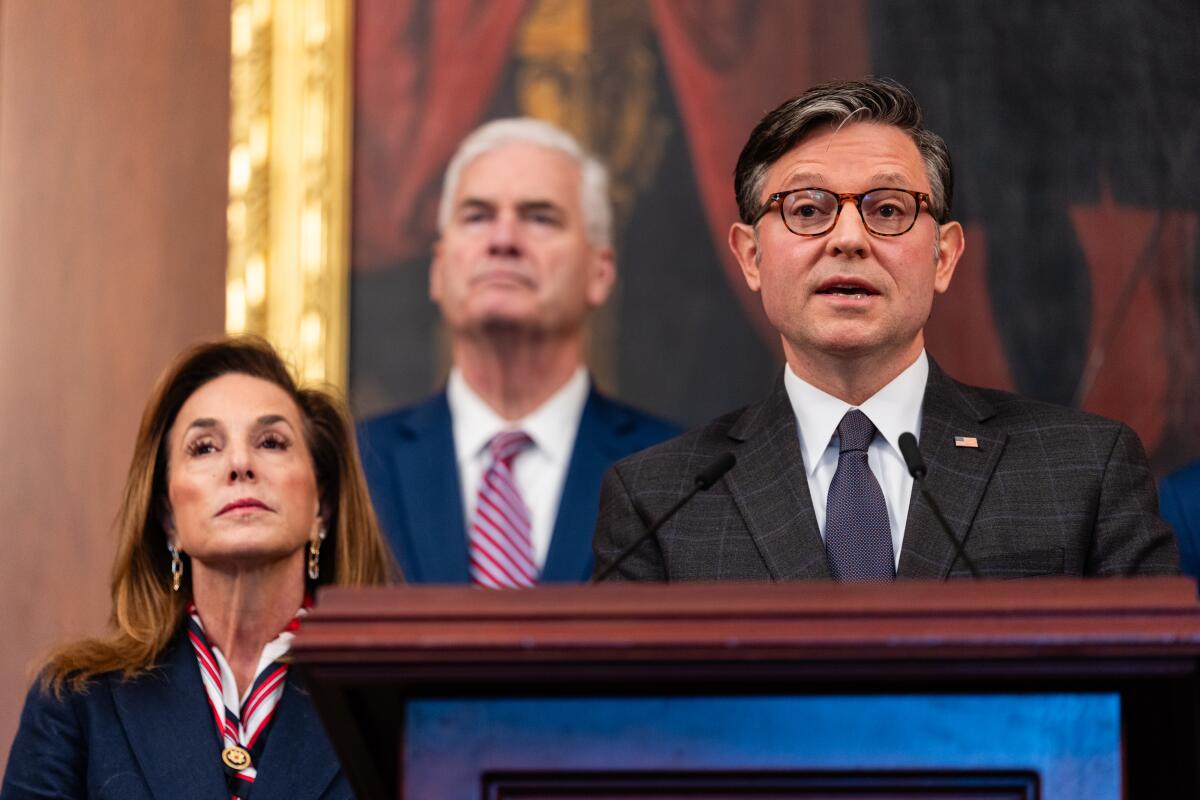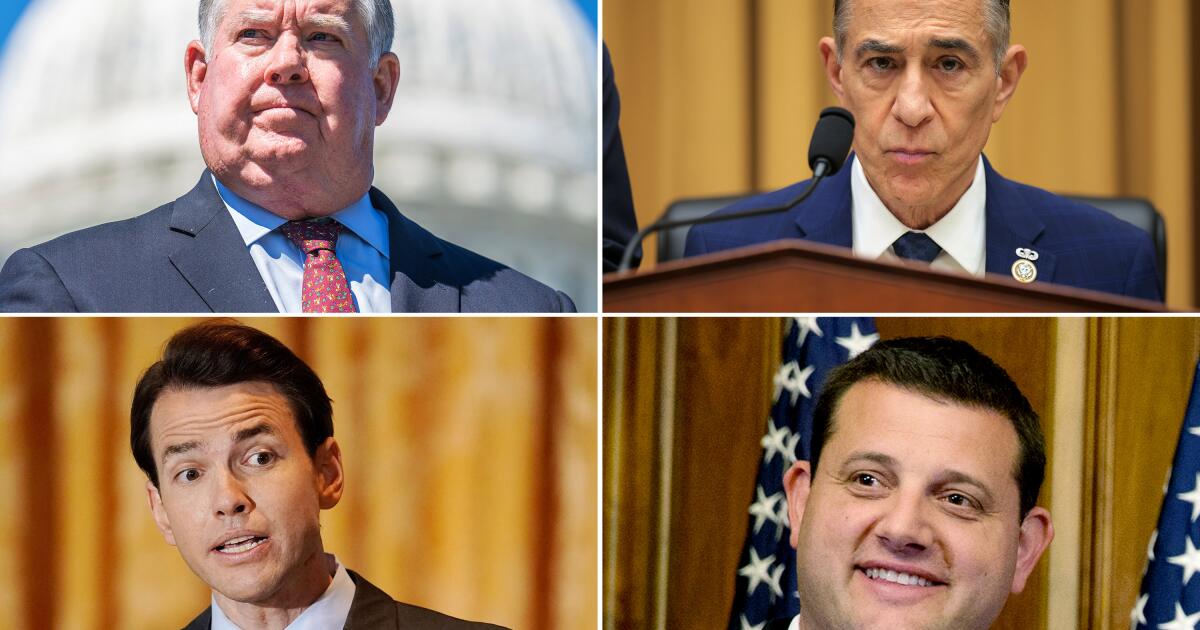For California delegation and its staffers, here’s what shutdown life looks like
WASHINGTON — Twenty-two days into the government shutdown, California Rep. Kevin Kiley spent an hour of his morning in Washington guiding a group of middle school students from Grass Valley through the empty corridors of the U.S. Capitol.
Normally, one of his staff members would have led the tour. But the Capitol is closed to all tours during the shutdown, unless the elected member is present. So the schoolchildren from Lyman Gilmore Middle School ended up with Kiley, a Republican from Rocklin, as their personal tour guide.
“I would have visited with these kids anyway,” Kiley said in his office after the event. “But I actually got to go on the whole tour of the Capitol with them as well.”
Kiley’s impromptu tour is an example of how members of California’s congressional delegation are improvising their routines as the shutdown drags on and most of Washington remains at a standstill.
Some are in Washington in case negotiations resume, others are back at home in their districts meeting with federal workers who are furloughed or working without pay, giving interviews or visiting community health centers that rely on tax credits central to the budget negotiations. One member attended the groundbreaking of a flood control project in their district. Others are traveling back and forth.
“I’ve had to fly back to Washington for caucus meetings, while the opposition, the Republicans, don’t even convene and meet,” Rep. Maxine Waters, a longtime Los Angeles Democrat, said in an interview. “We will meet anytime, anyplace, anywhere, with [House Speaker Mike] Johnson, with the president, with the Senate, to do everything that we can to open up the government. We are absolutely unified on that.”
The shutdown is being felt across California, which has the most federal workers outside the District of Columbia. Food assistance benefits for millions of low-income Californians could soon be delayed. And millions of Californians could see their healthcare premiums rise sharply if Affordable Care Act subsidies are allowed to expire.
For the California delegation, the fallout at home has become impossible to ignore. Yet the shutdown is in its fourth week with no end in sight.
In the House, Johnson has refused to call members back into session and prevented them from doing legislative work. Many California lawmakers — including Kiley, one of the few GOP lawmakers to openly criticize him — have been dismayed by the deadlock.
“I have certainly emphasized the point that the House needs to be in session, and that canceling a month’s worth of session is not a good thing for the House or the country,” Kiley said, noting that he had privately met with Johnson.
Kiley, who represented parts of the Sacramento suburbs and Lake Tahoe, is facing political uncertainty as California voters weigh whether to approve Proposition 50 on Nov. 4. The measure would redraw the state’s congressional districts to better favor Democrats, leaving Kiley at risk, even though the Republican says he believes he could still win if his right-leaning district is redrawn.
The Senate has been more active, holding a series of votes on the floor and congressional hearings with Atty. Gen. Pam Bondi and CIA Director John Ratcliffe. The chamber, however, has been unable to reach a deal to reopen the government. On Thursday, the 23rd day of the shutdown, the Senate failed to advance competing measures that would have paid federal employees who have been working without compensation.
The Republicans’ plan would have paid active-duty members of the military and some federal workers during the shutdown. Democrats backed a bill that would have paid all federal workers and barred the Trump administration from laying off any more federal employees.
“California has one of the largest federal workforces in the country, and no federal worker or service member should miss their paychecks because Donald Trump and Republicans refused to come to the table to protect Americans’ health care,” Sen. Alex Padilla said in a statement.
Working conditions get harder
The strain on federal employees — including those who work for California’s 54 delegation members — are starting to become more apparent.
Dozens of them have been working full time without pay. Their jobs include answering phone calls and requests from constituents, setting the schedules for elected officials, writing policy memos and handling messaging for their offices.
House Speaker Mike Johnson speaks about the shutdown at a news conference Thursday with other Republican House members.
(Eric Lee / Getty Images)
At the end of October, House staffers — who are paid on a monthly basis — are expected to miss their first paycheck.
Some have been quietly told to consider borrowing money from the U.S. Senate Federal Credit Union, which is offering a “government shutdown relief loan program” that includes a no-interest loan of up to $5,000 to be repaid in full after 90 days.
The mundane has also been disrupted. Some of the cafeterias and coffee carts that are usually open to staffers are closed. The lines to enter office buildings are long because fewer entrances are open.
The hallways leading to the offices of California’s elected officials are quiet, except for the faint sound of occasional elevator dings. Many of their doors are adorned with signs that show who they blame for the government shutdown.
“Trump and Republicans shut down the government,” reads a sign posted on the door that leads into Rep. Norma Torres’ (D-Pomona) office. “Our office is OPEN — WORKING for the American people.”
Rep. Ted Lieu, a Democrat from Torrance, posted a similar sign outside his office.
A sign is posted outside of the office of Rep. Ted Lieu, a California Democrat, in Washington on Wednesday.
(Ana Ceballos / Los Angeles Times)
Rep. Vince Fong, a Republican who represents the Central Valley, has been traveling between Washington and his district. Two weeks into the shutdown, he met with veterans from the Central Valley Honor Flight and Kern County Honor Flight to make sure that their planned tour of the Capitol was not disrupted by the shutdown. Like Kiley’s tour with the schoolchildren, an elected member needed to be present for the tour to go on.
“His presence ensured the tour could continue as planned,” Fong’s office said.
During the tour, veterans were able to see Johnson as well, his office said.
Shutdown highlights deep divisions
California’s congressional delegation mirrors the broader stalemate in Washington, where entrenched positions have kept both parties at a negotiation impasse.
Democrats are steadfast in their position that they will not agree to a deal unless Republicans extend the Affordable Care Act tax credits expiring at the end of the year, while Republicans are accusing Democrats of failing to reopen the government for political gain.
Kiley is one of the few Republicans who has called on Johnson to negotiate with Democrats on healthcare. Kiley said he thinks there is a “a lot of room to negotiate” because there is concern on both sides of the aisle if the tax credits expire.
“If people see a massive increase in their premiums … that’s not a good thing,” he said. “Especially in California, where the cost of living is already so high, and you’re suddenly having to pay a lot more for healthcare.”
Rep. Robert Garcia, the chair of the House Democratic Caucus, in a press event Wednesday with five other California Democrats talked about the need to fight for the healthcare credits.
Garcia, of Long Beach, said he recently visited a healthcare center in San Bernardino County that serves seniors with disabilities. He said the cuts would be “devastating” and would prompt the center to close.
“That’s why we are doing everything in our power to negotiate a deal that reopens the federal government and saves healthcare,” he said.
As the shutdown continues, many Democrats are digging their heels on the issue.
At an Oct. 3 event outside of Hollywood Presbyterian Medical Center, for instance, Rep. Laura Friedman held a news conference with nurses and hospital staff and said she would not vote for a bill to reopen the government unless there is a deal on healthcare.
Last week, the Glendale Democrat said her position hasn’t changed.
“I will not support a shutdown deal that strips healthcare from tens of thousands of my constituents,” she said.

